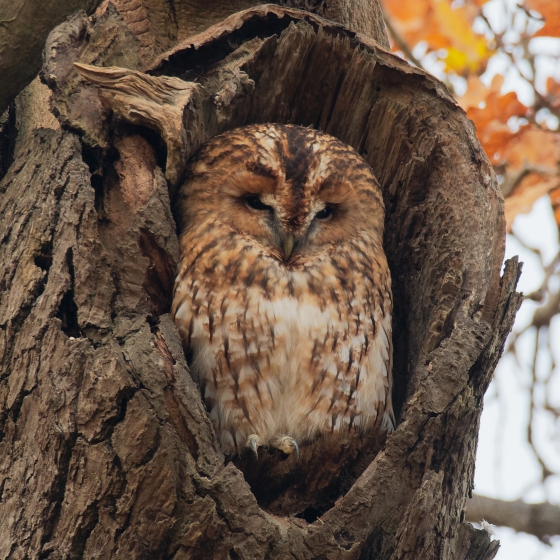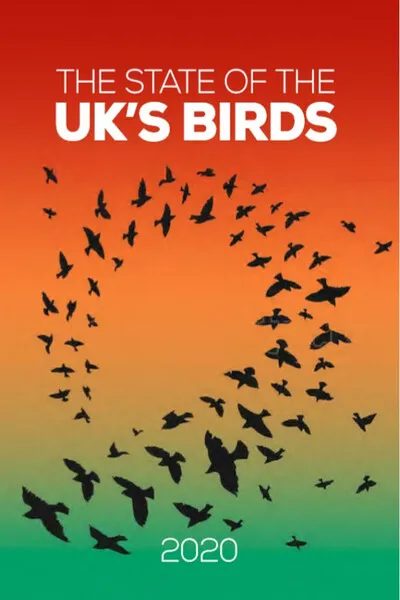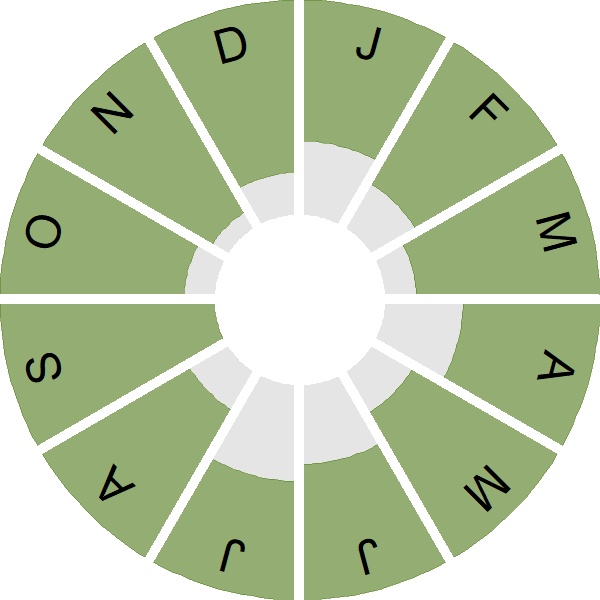Tawny Owl

Introduction
The brown and grey-streaked plumage of the Tawny Owl helps it to blend perfectly into its woodland habitat.
The Tawny Owl is our most widespread owl and can be found in forest, parks and large gardens. It is the source of the familiar 'too-whit-too-woo' call which is actually made by two birds – the female is responsible for the 'too-whit' part when she answers to the male's hooting 'too-woo'.
Ringing Scheme data show that Tawny Owls can live for over 20 years, often frequenting the same territory and even the same nest hole, or nest box, throughout their life. During the autumn Tawny Owls are at their most vocal, as pairs on established territories seek to deter dispersing juveniles from settling.
- Our Trends Explorer gives you the latest insight into how this species' population is changing.

Key Stats
Identification
Songs and Calls
Song:
Call:
Alarm call:
Status and Trends
Conservation Status
Population Change
As a nocturnal species, Tawny Owl is covered relatively poorly by the BTO's monitoring schemes. The pattern shown by CBC/BBS is a relatively stable one, however, in keeping with the longevity, sedentary behaviour, and slow breeding rate of this species. There has been a shallow downward trend in the index since the early 1970s. Gibbons et al. (1993) found evidence for a contraction of the species' UK range between the first two atlas periods, though these losses are now largely reversed (Balmer et al. 2013). Nevertheless, the downward drift of the UK population index has continued and, accordingly, the species moved from green to being amber listed in the latest review (Eaton et al. 2015). The BTO carried out new surveys of Tawny Owls in 2018/19, to investigate population trends following on from previous surveys in 1989 and 2005.
Distribution
Tawny Owls are resident in woodlands throughout Britain but absent from the Channel Islands and Ireland, although a bird presumed to be wild was present in Co. Down in 2013. Within Britain they are absent from the Northern Isles, Outer Hebrides, some of the smaller Inner Hebridean islands, the Isles of Scilly and treeless upland areas elsewhere, particularly in northern Scotland.
Occupied 10-km squares in UK
or view it on Bird Atlas Mapstore.
or view it on Bird Atlas Mapstore.
European Distribution Map
Distribution Change
The change maps show a 25% increase in the number of 10-km squares occupied by Tawny Owls since the 1981–84 Winter Atlas, contrasting with a 6% decrease since the 1968–72 Breeding Atlas. There are some areas where increases have definitely occurred, including the far north and west of Scotland, where maturing plantations have created suitable new habitat. Elsewhere apparent increases in winter are due primarily to better coverage.
Change in occupied 10-km squares in the UK
or view it on Bird Atlas Mapstore.
or view it on Bird Atlas Mapstore.
Seasonality
Tawny Owls are present throughout the year but not often recorded on daytime lists.
Weekly pattern of occurrence
The graph shows when the species is present in the UK, with taller bars indicating a higher likelihood of encountering the species in appropriate regions and habitats.

Habitats
Breeding season habitats
Relative frequency by habitat
The graph shows the habitats occupied in the breeding season, with the most utilised habitats shown at the top. Bars of similar size indicate the species is equally likely to be recorded in those habitats.

Movement
Britain & Ireland movement
Foreign locations of birds ringed or recovered in Britain & Ireland
Dots show the foreign destinations of birds ringed in Britain & Ireland, and the origins of birds ringed overseas that were subsequently recaptured, resighted or found dead in Britain & Ireland. Dot colours indicate the time of year that the species was present at the location.
- Winter (Nov-Feb)
- Spring (Mar-Apr)
- Summer (May-Jul)
- Autumn (Aug-Oct)

European movements
EuroBirdPortal uses birdwatcher's records, such as those logged in BirdTrack to map the flows of birds as they arrive and depart Europe. See maps for this species here.
The Eurasian-African Migration Atlas shows movements of individual birds ringed or recovered in Europe. See maps for this species here.
Biology
Productivity and Nesting
Nesting timing
Egg measurements
Clutch Size
Incubation
Fledging
Survival and Longevity
Survival is shown as the proportion of birds surviving from one year to the next and is derived from bird ringing data. It can also be used to estimate how long birds typically live.
View number ringed each year in the Online Ringing Report.
lifespan
Survival of adults
Survival of juveniles
Biometrics
Wing length and body weights are from live birds (source).
Wing length
Body weight
Ring Size
Classification, names and codes
Classification and Codes
- Order: Strigiformes
- Family: Strigidae
- Scientific name: Strix aluco
- Authority: Linnaeus, 1758
- BTO 2-letter code: TO
- BTO 5-letter code: TAWOW
- Euring code number: 7610
Alternate species names
- Catalan: gamarús euroasiàtic
- Czech: puštík obecný
- Danish: Natugle
- Dutch: Bosuil
- Estonian: kodukakk
- Finnish: lehtopöllö
- French: Chouette hulotte
- Gaelic: Comhachag-dhonn
- German: Waldkauz
- Hungarian: macskabagoly
- Icelandic: Náttugla
- Italian: Allocco
- Latvian: meža puce
- Lithuanian: namine peleda
- Norwegian: Kattugle
- Polish: puszczyk (zwyczajny)
- Portuguese: coruja-do-mato
- Slovak: sova obycajná
- Slovenian: lesna sova
- Spanish: Cárabo común
- Swedish: kattuggla
- Welsh: Tylluan Frech
- English folkname(s): Brown Owl, Howlet
Research
Causes of Change and Solutions
Causes of change
The causes of the decline are uncertain.
Further information on causes of change
The substantial improvements in nest success during the c.29-day egg stage could be linked to the declining impact of organochlorine pesticides, which were banned in the early 1960s. The numbers of fledglings per breeding attempt have increased steeply. Special post-breeding surveys of this species were conducted in autumn 2005 (Freeman et al. 2007a), following methodology established by an earlier survey in 1989 (Percival 1990). Integrated population modelling shows that all stages of the life cycle, including elements of both productivity and survival, make appreciable contributions to annual population change (Robinson et al. 2014). In Kielder Forest, vole numbers began fluctuating with a lower amplitude in the mid 1990s: the loss of productivity in years when voles are abundant may ultimately drive the Tawny Owl population there towards extinction (Millon et al. 2014).
Information about conservation actions
The drivers of change for this species are uncertain and hence potential solutions are also unclear.
Habitat fragmentation is one possible factor: Redpath (1995) found that owls occurred in all woods greater than 4 ha and that intermediate sized woods provided the optimum habitat. Provision of a network of suitable woods across the landscape is likely to be an important factor to help restore Tawny Owl populations. Other factors within the landscape may also have an effect; for example a study in Portugal found that Tawny Owls avoid major roads and that roads can therefore reduce populations (Silva et al. 2012), through disturbance and/or direct mortality (van der Horst et al. 2019); hence this may need to be considered when making decisions about infrastructure or other policy decisions which affect provision of habitat across the landscape.
Publications (2)
Large-scale citizen science survey of a common nocturnal raptor: urbanization and weather conditions influence the occupancy and detectability of the Tawny Owl Strix aluco
Author: Hanmer, H.J., Boothby, C., Toms, M.P., Noble, D.G. & Balmer, D.E.
Published: 2022
Prior to this study, most Tawny Owl population data was collected during daylight surveys for other species, or specialist, labour-intensive night-time surveys during the breeding season. The BTO Tawny Owl Calling Survey, however, harnessed the time and skill of thousands of volunteers to shed light on the impact of urbanisation on Tawny Owl populations, and used the data collected to develop the best methods for surveying these nocturnal raptors in the future.
01.02.22
Papers

The State of the UK's Birds 2020
Author: Burns, F., Eaton, M.A., Balmer, D.E., Banks, A., Caldow, R., Donelan, J.L., Douse, A., Duigan, C., Foster, S., Frost, T., Grice, P.V., Hall, C., Hanmer, H.J., Harris, S.J., Johnstone, I., Lindley, P., McCulloch, N., Noble, D.G., Risely, K., Robinson, R.A. & Wotton, S.
Published: 2020
The State of UK’s Birds reports have provided an periodic overview of the status of the UK’s breeding and non-breeding bird species in the UK and its Overseas Territories since 1999. This year’s report highlights the continuing poor fortunes of the UK’s woodland birds, and the huge efforts of BTO volunteers who collect data.
17.12.20
Reports State of Birds in the UK


